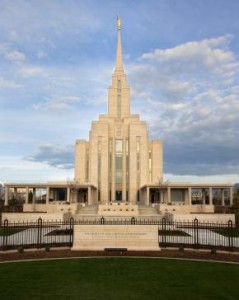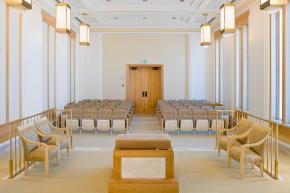
Oquirrh Mt. Utah
The temple is a sacred place, dedicated to be the House of the Lord. Anciently, God used sacred spaces both in nature and in holy edifices as a place to speak to man. The Garden of Eden, Mount Sinai, Moses’ Tabernacle, and Solomon’s Temple are all examples of such sacred spaces. Temples were considered holy mountains, where earth and heaven meet, and man and God communicate.
In modern LDS temples, three rites or ordinances are performed, which have the purpose of bringing people into God’s presence with their families.
The first is baptism for the dead. Latter-day Saints believe that all need the opportunity to be baptized with water and the Spirit, as commanded by Jesus (John 3:5, Alma 18). The Lord provides the way by allowing us to baptize by proxy on behalf of our deceased ancestors who have never had the opportunity to receive these ordinances. Each temple has a baptismal font for this purpose, and temple baptisms can be performed by worthy members ages twelve and over. In answering questions concerning salvation, Paul told the Corinthians that some baptize for the dead so they will rise with Christ in the resurrection (1 Corinthians 15:9). It is important to understand that those who die go to the Spirit World to await resurrection and judgment. In the Spirit World, people have free agency, volition, and the same personalities they had on earth. They are free to accept or reject the ordinances performed in their behalf.

Oquirrh Mt.
The next ordinance is the endowment. The endowment includes instruction that takes the individual on a symbolic journey through the Creation, the Fall, the struggles of this world, and finally the triumphant return of the individual back to the presence of God via Christ’s atonement. The endowment inspires and focuses us on following Christ back to God’s presence. During the endowment, the individual makes covenants of obedience with God. These promises are held so sacred between God and man, that they are kept personal and are not to be discussed outside the temple.
As the individual journeys through the endowment, he or she learns about our relationship with God. At the conclusion of the endowment, participants enter the Celestial room, representing God’s presence and kingdom. Many temple patrons enjoy sitting in the Celestial room to meditate or pray.The last rite occurs in the sealing room. In the center of the room is an altar where couples kneel to have their marriage sealed for mortality and for eternity.
To watch videos about here.

Oquirrh Mt.
At the altars, we can also seal children to their parents and the living to their deceased ancestors by proxy. In this way, the close and special relationships we have now can continue eternally. The temple is also a place for personal reflection and inspiration. God often will quietly reveal His will to those who seek His answers through the Holy Ghost.
For Latter-day Saints, the temple is holy. It is sacred. It is a place of light, peace, joy, and revelation. It is where we can prepare our families to stand with confidence in the presence of God. It is the House of the Lord.
There are those friends of other faiths who criticize Mormons for not allowing the public into temples at will, though open-houses are staged for the public before temples are dedicated to the service of the Lord. Mormons enter the temple to make holy covenants to keep a very strict, and higher law. There is no other reason to enter a temple, except to make covenants. If anyone in the general public is willing to make these covenants, then he or she will be enthusiastic about becoming a worthy member of the Mormon Church, too, and therefore able to enter the temple.

